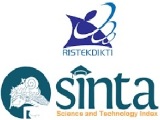EVALUASI KUALITAS PELAYANAN KEPADA MAHASISWA JURUSAN TEKNIK SIPIL DENGAN MODEL SERVQUAL UNTUK MENINGKATKAN MUTU LULUSAN
Abstract
Abstrak — Penelitian ini dilakukan untuk mengetahui kualitas layanan yang telah diberikan kepada siswa oleh Departemen Teknik Sipil. Hal ini mengingat kualitas mahasiswa pascasarjana diukur berdasarkan indeks prestasi kumulatif (IPK) lebih kecil dari 2,75, persentase meningkat dari tahun ke tahun. Dalam penelitian ini mencoba menganalisis kualitas pelayan kepada siswa dengan model melayani untuk mengetahui hal-hal yang mempengaruhi kualitas pelayanan. Selain itu, penelitian ini juga dapat bermanfaat untuk meningkatkan beberapa atribut layanan kepada siswa. Berdasarkan hasil penelitian ada kesenjangan antara layanan yang diterima dengan yang diharapkan oleh siswa atau kinerja JTS. Ini menunjukkan kesenjangan terbesar ke dimensi terkecil dari dimensi Berwujud (1,331), dimensi Reabilitas (1,015), dimensi Emphaty (0,969), dimensi Assurance (0,802), dan dimensi Responsiveness (0,801). Nilai gap negatif terbesar adalah dimensi reabilitas kemudahan memperoleh layanan akademik (bimbingan PKL dan TGA) yaitu -1,470, kehadiran dosen sesuai jadwal kursus (tepat waktu) dengan nilai gap -1,465 dan dimensi Assurance dengan atribut layanan dosen. selalu menemani siswa selama kegiatan latihan -1,460).
Kata kunci : Servqual, Kualitas Layanan, Gap.
Abstract — This research is conducted to know the quality of service that has been given to the students by the Department of Civil Engineering. This is considering the quality of graduate students measured based on cumulative achievement index (GPA) is smaller than 2.75, the percentage increases from year to year In this study tried to analyze the quality of waiters to students with servequal model to know things that affect the quality of service. In addition, this research can also be useful to improve some attributes of services to students. Based on the results of research there is a gap between the service received with the expected by the student or the performance of JTS. This shows the largest gap to the smallest of the Tangible dimensions (1.331), Reability dimensions (1.015), Emphaty dimensions (0.969), Assurance dimensions (0.802), and Responsiveness dimensions (0.801). The biggest negative gap value is the reability dimension of ease of obtaining academic service (PKL and TGA guidance) that is -1,470, Lecturers attendance according to schedule of course (on time) with gap value -1,465 and Assurance dimension with attribute of lecturer service always accompany student during practice activity -1,460).
Keywords: Servqual, Service Quality, Gap.
Keywords
Full Text:
PDF (Bahasa Indonesia)References
Jogiyanto. 2008., Pedoman Survei Kuesioner, Badan Penerbit Fakultas Ekonomika dan Bisnis UGM, Yogyakarta.
Kotler,P. 2005,. Manajemen Pemasaran, edisi kesebelas,jilid 2,Penerbit PT Indeks Kelompok Gramedia.
Masri.S, Sofian.E.1999. Metode Penelitian Survai, PT.Pustaka LP3ES Indonesia, Jakarta,
Sudjana,.2005 Metoda Statistik, PT. Tarsito Bandung, Bandung,
Sugiyono., 2009. Metode Penelitian Kuantitatif Kualitatif dan R&D, penerbit Alfabeta Bandung
Tjiptono,.F,.2005, Manajemen Jasa, Penerbit Andi Yogyakarta, 2004.
Tjiptono. F., Diana. A., 2001. Total Quality Management, Penerbit Andi Yogyakarta
Tjiptono.F,. 2000, Total Quality Management, Penerbit Andi Yogyakarta,2000.
DOI: http://dx.doi.org/10.30811/portal.v11i1.1514
Refbacks
- There are currently no refbacks.
Copyright (c) 2019 Herri Mahyar, Rizal Syahyadi






